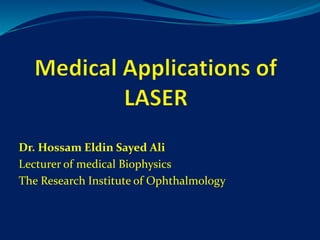
Medical applications of laser 1
- 1. Dr. Hossam Eldin Sayed Ali Lecturer of medical Biophysics The Research Institute of Ophthalmology
- 2. What Is LASER The acronym LASER stands for Light Amplification by Stimulated Emission of Radiation The Laser concept was first demonstrated in the microwave region in 1954 by Charles Townes and co-workers. They projected a beam of ammonia molecules through a system of focusing electrodes. When microwave power of appropriate frequency was passed through the cavity, amplification occurred and the term microwave amplification by stimulated emission of radiation (M.A.S.E.R.) was born.
- 3. The term laser was first coined in 1957 by physicist Gordon Gould. A year later, Townes worked with Arthur Schawlow and the two proposed the laser, receiving a patent in 1960. That same year, Theodore Maiman, a physicist at Hughes Research Laboratories, invented the first practical laser. This laser was a solid state type, using a pink ruby crystal surrounded by a flash tube enclosed within a polished aluminum cylindrical cavity cooled by forced air. The ruby cylinder was polished on both ends to be parallel to within a third of a wavelength of light. Each end was coated with evaporated silver. This laser operated in pulsed mode. Two years later, a continuous ruby laser was made by replacing the flash lamp with an arc lamp.
- 4. components of a laser producing device The fundamental components of a laser producing device are: a. Energy source b. Optical (Resonating) cavity c. Active lasing medium d. Cooling system e. Delivery system
- 7. The properties of laser radiation Laser light has four unique characteristics that differentiate it from ordinary light: these are •Coherence •Directionality •Monochromatic •High intensity
- 8. Coherence Electron transition in ordinary light sources is random in time. The photons emitted from ordinary light sources have different energies, frequencies, wavelengths, or colors. Hence, the light waves of ordinary light sources have many wavelengths. Therefore, photons emitted by an ordinary light source are out of phase. In laser, the electron transition occurs artificially in specific time. All the photons emitted in laser have the same energy, frequency, or wavelength. Hence, the light waves of laser light have single wavelength or color. Therefore, the wavelengths of the laser light are in phase in space and time., a large amount of power can be concentrated in a narrow space.
- 9. Directionality In conventional light sources photons travel in random directions. Therefore, these light sources emit light in all directions. In laser, all photons will travel in same direction. The width of a laser beam is extremely narrow. Hence, a laser beam can travel to long distances without spreading. If an ordinary light travels a distance of 2 km, it spreads to about 2 km in diameter. A laser light travels a distance of 2 km, it spreads to a diameter less than 2 cm.
- 10. Monochromatic Monochromatic light means a light containing a single color or wavelength. The photons emitted from ordinary light sources have different energies, frequencies, wavelengths, or colors. In Laser, all the emitted photons have the same energy, frequency, or wavelength. Hence, the light waves of laser have single wavelength or color. Therefore, laser light covers a very narrow range of frequencies or wavelengths.
- 11. High Intensity The intensity of a wave is the energy per unit time flowing through a unit normal area. In an ordinary light source, the light spreads out uniformly in all directions. If you look at a 100 Watt lamp filament from a distance of 30 cm, the power entering your eye is less than 1/1000 of a watt. In laser, the light spreads in small region of space and in a small wavelength range. Hence, laser light has greater intensity when compared to the ordinary light. Thus, even a 1 Watt laser would appear many thousand times more intense than 100 Watt ordinary lamp.
- 12. Types of LASER There are many types of LASERs available for different purposes. Depending upon the sources they can be described as below. Solid State LASER In this kind of LASERs solid state, materials are used as active medium. The solid state materials can be ruby, neodymium-YAG (yttrium aluminum garnet) etc. Gas LASER These LASERs contain a mixture of helium and Neon. This mixture is packed up into a glass tube. It acts as active medium. We can use Argon or Krypton or Xenon as the medium. CO2 and Nitrogen LASER can also be made.
- 13. Dye or Liquid LASER In this kind of LASERs organic dyes like Rhodamine 6G in liquid solution or suspension used as active medium inside the glass tube. Excimer LASER Excimer LASERs (the name came from excited and dimers) use reactive gases like Chlorine and fluorine mixed with inert gases like Argon or Krypton or Xenon. These LASERs produce light in the ultraviolet range. Chemical LASER A chemical laser is a LASER that obtains its energy from a chemical reaction. Examples of chemical lasers are the chemical oxygen iodine laser (COIL), all gas-phase iodine laser (AGIL), and the hydrogen fluoride laser, deuterium fluoride laser etc Semiconductor LASER In these lasers, junction diodes are used. The semiconductor is doped by both the acceptors and donors. These are known as injection laser diodes. Whenever the current is passed, light can be seen at the output.